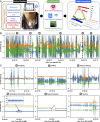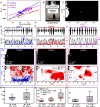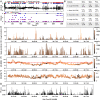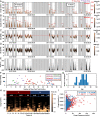Automated, multiparametric monitoring of respiratory biomarkers and vital signs in clinical and home settings for COVID-19 patients
- PMID: 33893178
- PMCID: PMC8126790
- DOI: 10.1073/pnas.2026610118
Automated, multiparametric monitoring of respiratory biomarkers and vital signs in clinical and home settings for COVID-19 patients
Abstract
Capabilities in continuous monitoring of key physiological parameters of disease have never been more important than in the context of the global COVID-19 pandemic. Soft, skin-mounted electronics that incorporate high-bandwidth, miniaturized motion sensors enable digital, wireless measurements of mechanoacoustic (MA) signatures of both core vital signs (heart rate, respiratory rate, and temperature) and underexplored biomarkers (coughing count) with high fidelity and immunity to ambient noises. This paper summarizes an effort that integrates such MA sensors with a cloud data infrastructure and a set of analytics approaches based on digital filtering and convolutional neural networks for monitoring of COVID-19 infections in sick and healthy individuals in the hospital and the home. Unique features are in quantitative measurements of coughing and other vocal events, as indicators of both disease and infectiousness. Systematic imaging studies demonstrate correlations between the time and intensity of coughing, speaking, and laughing and the total droplet production, as an approximate indicator of the probability for disease spread. The sensors, deployed on COVID-19 patients along with healthy controls in both inpatient and home settings, record coughing frequency and intensity continuously, along with a collection of other biometrics. The results indicate a decaying trend of coughing frequency and intensity through the course of disease recovery, but with wide variations across patient populations. The methodology creates opportunities to study patterns in biometrics across individuals and among different demographic groups.
Keywords: COVID-19; biomarkers; digital health; respiratory disease; wearable electronics.
Copyright © 2021 the Author(s). Published by PNAS.
Conflict of interest statement
Competing interest statement: X.N., H.J., J.Y.L., K.L., A.J., S.X., and J.A.R. report inventorships and potential royalties in patents assigned to Northwestern University. M.K. and J.Y.L. are employees of a small private company with a commercial interest in the technology. A.R.B., S.X., and J.A.R. report equity ownership in a small private company with a commercial interest in the technology.
Figures






Similar articles
-
Reliability of wireless monitoring using a wearable patch sensor in high-risk surgical patients at a step-down unit in the Netherlands: a clinical validation study.BMJ Open. 2018 Feb 27;8(2):e020162. doi: 10.1136/bmjopen-2017-020162. BMJ Open. 2018. PMID: 29487076 Free PMC article.
-
Miniaturized wireless, skin-integrated sensor networks for quantifying full-body movement behaviors and vital signs in infants.Proc Natl Acad Sci U S A. 2021 Oct 26;118(43):e2104925118. doi: 10.1073/pnas.2104925118. Proc Natl Acad Sci U S A. 2021. PMID: 34663725 Free PMC article.
-
Differential cardiopulmonary monitoring system for artifact-canceled physiological tracking of athletes, workers, and COVID-19 patients.Sci Adv. 2021 May 12;7(20):eabg3092. doi: 10.1126/sciadv.abg3092. Print 2021 May. Sci Adv. 2021. PMID: 33980495 Free PMC article.
-
An Evaluation of Biometric Monitoring Technologies for Vital Signs in the Era of COVID-19.Clin Transl Sci. 2020 Nov;13(6):1034-1044. doi: 10.1111/cts.12874. Epub 2020 Oct 12. Clin Transl Sci. 2020. PMID: 32866314 Free PMC article. Review.
-
An Overview of Signal Processing Techniques for Remote Health Monitoring Using Impulse Radio UWB Transceiver.Sensors (Basel). 2020 Apr 27;20(9):2479. doi: 10.3390/s20092479. Sensors (Basel). 2020. PMID: 32349382 Free PMC article. Review.
Cited by
-
Pregnancy outcomes in infertility patients diagnosed with sleep disordered breathing with wireless wearable sensors.Sleep Med. 2022 Dec;100:511-517. doi: 10.1016/j.sleep.2022.09.026. Epub 2022 Oct 12. Sleep Med. 2022. PMID: 36306629 Free PMC article.
-
Sensory artificial cilia for in situ monitoring of airway physiological properties.Proc Natl Acad Sci U S A. 2024 Nov 12;121(46):e2412086121. doi: 10.1073/pnas.2412086121. Epub 2024 Nov 7. Proc Natl Acad Sci U S A. 2024. PMID: 39508764 Free PMC article.
-
Applications of flexible materials in health management assisted by machine learning.RSC Adv. 2025 Jun 30;15(28):22386-22410. doi: 10.1039/d5ra02594j. eCollection 2025 Jun 30. RSC Adv. 2025. PMID: 40599562 Free PMC article. Review.
-
Development of a Miniaturized Mechanoacoustic Sensor for Continuous, Objective Cough Detection, Characterization and Physiologic Monitoring in Children With Cystic Fibrosis.IEEE J Biomed Health Inform. 2024 Oct;28(10):5941-5952. doi: 10.1109/JBHI.2024.3415479. Epub 2024 Oct 3. IEEE J Biomed Health Inform. 2024. PMID: 38885105 Free PMC article.
-
An implantable device for wireless monitoring of diverse physio-behavioral characteristics in freely behaving small animals and interacting groups.Neuron. 2024 Jun 5;112(11):1764-1777.e5. doi: 10.1016/j.neuron.2024.02.020. Epub 2024 Mar 26. Neuron. 2024. PMID: 38537641 Free PMC article.
References
-
- Centers for Disease Control and Prevention , Coronavirus disease 2019 (COVID-19). Cases in the U.S. New cases by day. https://covid.cdc.gov/covid-data-tracker/. Accessed 26 December 2020.
Publication types
MeSH terms
Substances
Grants and funding
LinkOut - more resources
Full Text Sources
Other Literature Sources
Medical

